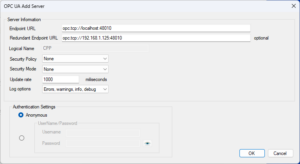OPC Client for EcoStruxure Building Operation

View and modify values from any OPC DA/UA Server
The OPC client for EcoStruxure Building Operation software allows Schneider Electric’s customers who are using the EcoStruxure Building Operation system (EBO) to easily view (and modify) data from 3rd party OPC systems. Both OPC DA and OPC UA are supported. For example: Other BMS systems, SCADA systems and PLCs.
Multiple OPC servers are supported.

Scalability and availability
The number of the OPC items you can share with your EBO system is virtually unlimited. The only limit is the amount of memory (RAM) in your computer.
The OPC client for EcoStruxure Building Operation will automatically try to reconnect with a disconnected OPC server once a minute until a successful connection. When the OPC server is reconnected, the items’ quality will be changed from Bad to Good.

EBO OPC Client Features
The OPC client for EcoStruxure Building Operation (EBO) allows customers to connect with any 3rd party OPC server (DA and UA) and display OPC item values in their EBO system.
For any new development, given the choice, OPC UA should be used. The only reason to use OPC DA now is if you are connecting to a legacy product that only supports OPC DA and cannot be replaced or upgraded.
The OPC client for EcoStruxure Building Operation (EBO) can automatically discover all OPC groups and items and save the time of manually creating the groups and browsing the OPC items. See how - https://www.youtube.com/watch?v=aUTZw6XjmJE
When the OPC client for EcoStruxure Building Operation detects that an OPC server is disconnected, it will mark all EWS server's items' quality as Uncertain or Offline, so that the EBO user will notice the disconnection.
The OPC client for EcoStruxure Building Operation will automatically try to reconnect with the OPC server once a minute until a successful connection. When the problem is resolved, the items’ quality will be changed to Good.
The number of the OPC items you can share with your EBO system is virtually unlimited. The only limit is the amount of memory (RAM) in your computer.
OPC DA is based on the Microsoft's DCOM and had some significant limitations inherent to that technology. To get away from the limitations of DCOM, the OPC Foundation developed, and released, a new version of the OPC protocol called OPC UA.
Thanks to its new properties and well-designed architecture, the OPC UA protocol is rapidly gaining popularity among automation system vendors. OPC UA gateways are installed by a growing number of industrial enterprises across the globe.
The protocol is increasingly used to set up communication between components of industrial internet of things and smart city systems.
The security of technologies that are used by many automation system developers and have the potential to become ubiquitous among industrial facilities across the globe is one the highest-priority areas of research for Kaspersky Lab ICS CERT. This was our main reason to do an analysis of OPC UA.
The OPC client for EcoStruxure Building Operation supports standard OPC UA security by using certificates. Without a certificate the OPC client for EcoStruxure Building Operation will not be able to connect with the OPC UA servers.
OPC UA redundant servers play a critical role in industrial and automation systems by enhancing reliability, ensuring continuous operation, and minimizing downtime. Here’s why they are important:
1. High Availability
- Redundant servers ensure uninterrupted communication by allowing a backup server to take over if the primary server fails.
- This is critical for industries where downtime can result in significant financial loss or safety hazards, such as manufacturing, utilities, and healthcare.
2. Fault Tolerance
- A redundant OPC UA server setup ensures that system failures (e.g., hardware, software, or network issues) do not lead to complete system breakdown.
- By distributing the workload and switching to a backup server, the system remains operational.
3. Improved System Reliability
- Redundancy increases the overall system's reliability by ensuring that data is always available and services are not disrupted.
- This helps maintain critical processes and data integrity, especially in real-time monitoring systems.
4. Load Balancing
- Some redundant configurations support load balancing, where client requests are distributed across multiple servers to optimize resource utilization and performance.
5. Disaster Recovery
- In the event of a primary server failure, the backup server seamlessly takes over, preventing data loss and ensuring that ongoing processes are unaffected.
- This makes recovery faster and more efficient.
6. Regulatory Compliance
- In industries where compliance and reporting standards require consistent data logging and availability, redundant servers help meet these obligations without interruption.
7. Scalability
- Redundant server setups are easily scalable to support growing system demands, accommodating more clients or data points as needed.
8. Client Transparency
- OPC UA supports built-in mechanisms for redundancy, allowing client applications to automatically detect and switch to a backup server without manual intervention, reducing complexity and improving user experience.
In case the EBO-OPC Client fails to connect with the primary OPC UA server, it will automatically switch to the secondary (redundant) OPC UA server. In case the EBO-OPC Client fails to connect with the secondary OPC UA server, it will automatically switch to the primary OPC UA server.
The EBO-OPC Client's OPC UA redundancy ensures systems meet the high standards of reliability, safety, and performance that modern industries demand.
EBO OPC Client Technical Specifications
- Microsoft Windows® 2016/2019/2022 Server, Windows® 10 64 bit, Windows® 11 64 bit
- Microsoft .NET version 4.5 framework
- Microsoft SQL Server or SQL Server Express version (required for the SmartConnector)
- Schneider Electric SmartConnector version 2.4.17 or higher
- Schneider Electric EcoStruxure Building Operation (EBO) workstation version 1.9 or higher
- Physical or Virtual server







